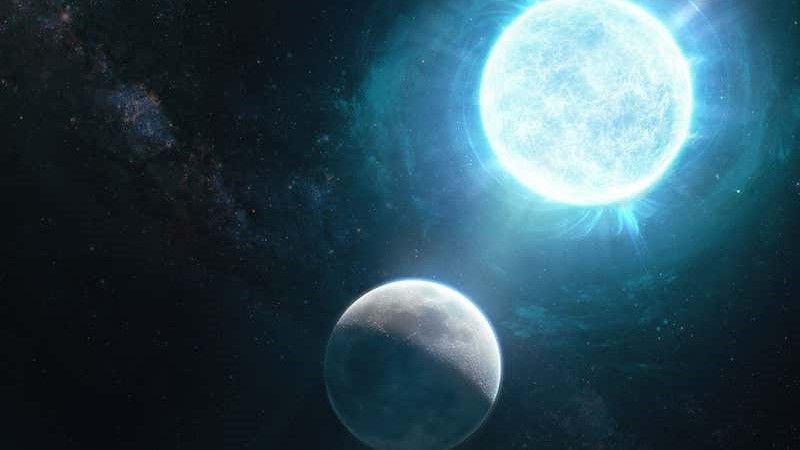
The discovery of a moon-size zombie star transforming into another type of stellar corpse could upend astronomers' understanding of how stars evolve.
The cosmic zombie — an embering core of a dead star, or a white dwarf — is about the size of Earth's moon, making it the smallest white dwarf ever found. Despite being tiny, with a radius of 2,670 miles (4,300 kilometers) compared to our sun's 432,470-mile (696,000 km) radius, the stellar corpse has a ginormous mass of about 1.35 times that of the sun.
Dubbed ZTF J190132.9+145808.7, the white dwarf is located about 130 light-years from Earth; and it is rotating super fast, completing a full revolution every 6.9 minutes. Perhaps even weirder, the star's magnetic field is up to 1 billion times stronger than that of Earth’s at its surface, or 900 times the strength of the sun’s magnetic field.
Related: The 12 strangest objects in the universe
Scientists believe that the dense, smoldering zombie is shrinking. This could mean that it's about to explode, or more surprisingly, transform itself into a very different type of undead star that’s usually created only by a supernova: a neutron star.
"We caught this very interesting object that wasn't quite massive enough to explode," Ilaria Caiazzo, a research associate in theoretical astrophysics at Caltech and lead author of a new study that describes the star, said in a statement. "We are truly probing how massive a white dwarf can be."
White dwarfs form when stars between one-10th and eight times the mass of the sun run out of fuel for nuclear fusion. When this happens, the stars slough off their outer layers like the rind of a fruit, revealing a compact, dense, white-hot core that slowly cools over time. According to researchers, 97% of the stars in the Milky Way are destined to become white dwarfs, according to a 2001 study in the journal Publications of the Astronomical Society of the Pacific.
Neutron stars are also stellar corpses, but these morbid objects are instead left behind when stars heftier than eight times the mass of the sun end their lives in gigantic explosions called supernovas. Neutron stars are much denser than white dwarfs. They are so dense, in fact, that they get their name from the way their powerful gravitational fields are able to squish protons and electrons together — forming an orb of tightly packed neutrons with a mass 10 to 25 times that of the sun.
Usually the processes that create these two stellar remnants are very distinct — sloughing off in the first case and enormous explosions in the other — but this white dwarf is different. The researchers think that it may be shrinking so much, it could be on the verge of transforming into a neutron star. Observing a metamorphosis like this could reveal a totally new route to neutron star formation.
"This is highly speculative, but it's possible that the white dwarf is massive enough to further collapse into a neutron star," Caiazzo said. "It is so massive and dense that, in its core, electrons are being captured by protons in nuclei to form neutrons." All those electrons pushed out on the star against the force of gravity. But once those electrons and protons form neutrons, that pressure gives way, and at some point the star's core collapses, Caiazzo added.
The researchers believe that the white dwarf's unusually high mass may be the result of a Frankenstein-like merger of two smaller white dwarfs. This could have happened after a binary star system — consisting of two stars orbiting each other — ended its cosmic duet with the creation of two white dwarfs that were drawn together by gravity. The subsequent collision caused a giant explosion called a type Ia supernova. What followed was a movie monster-esque stitching together of the two undead husks, producing a combined white dwarf with a heaving mass and a greater gravitational pull that sucks the stellar husks into an even denser sphere.
The researchers want to look for more white dwarfs like this so they can see how common the new potential route of stellar evolution actually is.
"There are so many questions to address, such as what is the rate of white dwarf mergers in the galaxy, and is it enough to explain the number of type Ia supernovae? How is a magnetic field generated in these powerful events, and why is there such diversity in magnetic field strengths among white dwarfs?" Caiazzo said. "Finding a large population of white dwarfs born from mergers will help us answer all these questions and more."
The team's findings were published June 30 in the journal Nature.
Originally published on Live Science.
Article From & Read More ( Frankenstein star could be on the brink of a startling transformation - Livescience.com )https://ift.tt/3dCBC4j
Science
No comments:
Post a Comment